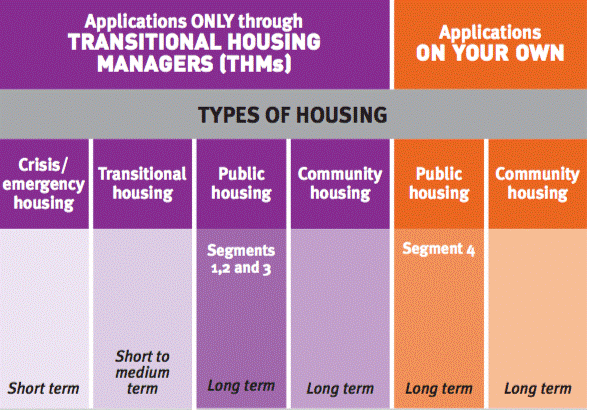What housing options do I have?
Moving around is a tiring and stressful process, especially if you can’t stay anywhere for a long period. When applying for long-term housing, there are different long-term housing options such as renting in the private rental market or applying for social housing.
Are you in temporary housing and looking for longer-term options?
Social Housing
The diagram below shows how different types of social housing are related to one another:

What is social housing?
The term ‘social housing’ can sometimes be confusing—it includes both public housing and community housing options as explained below.
Public Housing
Public housing is provided by Department of Families, Fairness and Housing —HousingVic at an affordable rent that is calculated as a percentage of household income. Waiting lists in Victoria are very long, which means that public housing is certainly not the way to solve your immediate housing crisis.
There are different housing types offered by HousingVic. These can include high-rise apartments, medium-density apartments (often referred to as ‘walk ups’ as they don’t have a lift), townhouses and houses. A general rule-of-thumb is that if you list your preference to live in the inner suburbs of Melbourne, expect to be offered a high-density or medium-density apartment. The further out you go, the more likely you are to be offered a house.
Getting into public housing can be difficult.
Community Housing
Community housing is provided through non-government and not-for-profit organisations in Victoria. These organisations include housing associations and housing providers. They offer long-term housing options to tenants at an affordable rent. They are separate from the HousingVic and you need to contact the organisations directly to make an application.
This HousingVic webpage has information on community housing.
Private rental
A ‘private rental’ is when you rent a property directly from the property owner or through a real estate agent.
Often when you are applying for a private rental, you will be asked to pay a bond.
A bond is a security in case there is a dispute at the end of your tenancy over things like damage, cleaning or unpaid rent. By law, if you pay a bond it must be held by the bond authority until your tenancy ends.
If you need assistance with the bond, you may be able to borrow the money for an interest-free bond RentAssist bond loan from the state government.
For more tips on applying for a rental property, see Tenants Victoria.
Helpful resources for stay in your rental:
If you are currently renting a property directly from the property owner or through a real estate agent, there are resources available to help you stay in that property.
Dear Landlord: A free online self-help resource for renters in Victoria – Justice Connect
If you’re a Victorian renter behind in rent or worried you might fall behind in rent, you can use Justice Connect’s ‘Dear Landlord’ tool to:
- Understand your options to stay safely in your home.
- Draft a letter to your rental provider to negotiate a payment plan or rent reduction.
- Prepare for VCAT or lodge a VCAT review application if you missed your hearing.
- Find important financial and legal help.
Landlord problems – Tenants Victoria
Tenants Victoria’s help lines have a heavy demand and it can be hard to get though. Their website has helpful information for tenants: Help, FAQs and Resources for Renters – Renters & Housing Union
Landlords and agents must give you this Consumer Affairs Victoria Renters Guide guide on or before the day you move in.
Talk to someone at WIRE to talk through what your circumstances are, and how to prioritise your time and efforts.
– In person at 1/673 Bourke St, Melbourne CBD
– Call us on our Phone Support Line on 1300 134 130
– Reach out via Live Web Chat
– Email us at support@wire.org.au
Updated July 2023.
